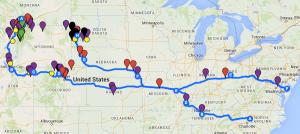I never truly presented my thoughts, impressions and photographs from my 2015 cross-country road trip. At least not to the extent I wanted. In reality, I left little time for blogging while I was on the road. Wi-fi hotspots were few and far in between for the majority of my destinations. Cell coverage was deplorable; more about that later!
I wish to devote some time to a collection of posts highlighting destinations, lessons learned, travel tips and photography from 29 days on the road by myself with a dog for company. I hope you will indulge me:
The Whole Trip
In total I would drive nearly 8,000 miles, visiting:
- 5 National Monuments
- 4 National Parks
- 3 National Scenic Highways
- 10 National Wildlife Refuges
- 2 State Parks
- 3 Wilderness Areas
- 3 Wildlife Management Areas
I hiked more than 40 miles of trails.
I lost 15 pounds on the trip!
Spent 2 nights in a hotel, 22 nights camping and 4 nights with friends.
Added 71 new species to my bird list.
Still wished I had stopped for that camel ride in Montana. 🙂
The Bare Necessities
The total trip costs less than $1800, making the trip come in at around $60 a day! Although, this includes some extra costs like a new backpack, some camping gear and a new tent mid-trip. Gas prices were averaging between $2.50-$2.75 per gallon, although gas around Yellowstone NP and northwestern Wyoming was a bit higher averaging $2.90-$3.10 per gallon. If gas prices remain low in the coming years, I would love to re-run a portion of this road trip!
I booked all of my lodging in advance through the respective state parks or on recreation.gov. While this may have been unnecessary for about half of my lodging options, not having to worry about whether a campground would be full when I got there was worth the effort. Many of the larger state parks and national parks allow reservations up to 6 months or a year prior to your selected date. While most leave some sites available for walk-ins, they are on a first-come-first-serve basis. Prior booking for Yellowstone NP-WY, Badlands NP-SD and Custer SP-SD was a wise choice as each was full when I arrived. On the flip-side, there were 2-3 nights where I wish I could have been more flexible and if I had the proper change, probably would have foregone one reservation to stay closer to one of my destinations (more on that later).
In the Beginning
The first planned stop of the trip was a guilty pleasure, of sorts. The Parthenon: in Nashville, TN. I never knew it was there until watching the first Percy Jackson film. It was in the back of my mind and since I needed to crash somewhere in TN or KY the first night, I though why not?
The full-size replica sits in Centennial Park, southwest of the city center. A walking trail encircles a small lake and the Parthenon. Given my arrival at 0630 in the morning, the park was quiet and parking easy to find off 25th Avenue. The numerous squirrels delighted Ari (my Ibizan Hound) to the point of craziness. I thought he would break off my arms! A few runners and bikers would pass us on our circuit. A brisk walk in the morning was just what I needed to gear up for a very long day of driving ahead!


